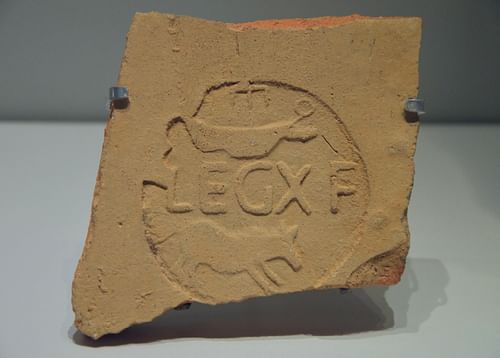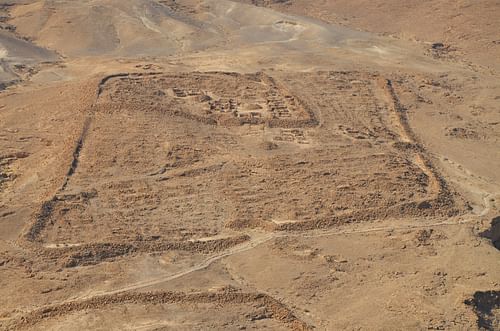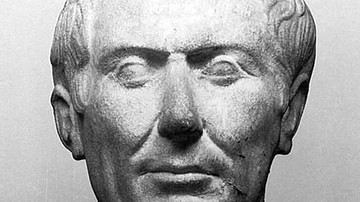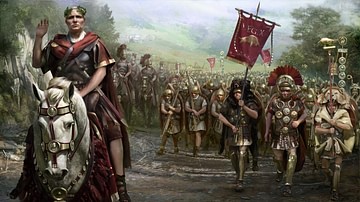
Legio X Fretensis was a legion of the Roman army formed by either Julius Caesar or Augustus. The legion spent most of its existence in the East, primarily in Judea. It participated in Corbulo’s two Armenian campaigns as well as Vespasian and Titus’ battle against the Great Jewish Revolt of 66 CE, besieging both Jerusalem and Masada.
Name & Origin
Part of the mystery surrounding the legion is the origin of its name 'Fretensis'. The word comes from fretum meaning "of the strait". Those who believe the legion was formed by Julius Caesar (100-44 BCE) contend the name comes from his crossing of the Otranto Strait with the 10th on route to Epirus. Those who favor Octavian, the future Augustus (27 BCE - 14 CE), claim it comes from his battle against Sextus Pompey (c. 67-35 BCE) in the Strait of Messina. Whichever it may be, the title indicates the legion could have been formed from Roman sailors. What is accepted, however, is that a legion known only as the Tenth served with Julius Caesar during his Gallic and Civil Wars. After his death, it was inherited by Octavian.
Legions during the time of Caesar were identified by their number, not their name. Historians make references to a 10th legion created by Caesar during his time as provincial governor of Further Spain (Hispania Ulterior). The Greek historian Plutarch (c. 45/50 - 120/125 CE) claims that after Caesar arrived in Spain, he raised ten new cohorts to go with the 20 already in existence. These new cohorts may well have been formed into a legion, the Tenth. As evident from the Battle of Pharsalus (48 BCE) and the Battle of Munda (45 BCE), Caesar placed considerable confidence in his Tenth, positioning them on the extreme right in his battle formation, a position of both prestige as well as danger. Plutarch cited an example of the commander’s confidence in the Tenth that took place during his decade in Gaul. Having found his officers to be apprehensive, Caesar went on a rant against these young men of nobility:
… he called them together and advised them to march off and not run the hazard of a battle against their inclination since they had such weak and unmanly feelings, telling them he would take only the tenth legion, and march against the barbarians. (791)
The Tenth appreciated this compliment "and deputed some of their body to pay him their acknowledgements and thanks" (791). Another example of the legion’s loyalty - a legion he considered to be his personal bodyguard - comes from a proposed meeting with the German king Ariovistus. In his own words (he always wrote in the third person) Caesar wrote that the king "suddenly raised the demand that Caesar should on no account bring infantry." Since he could only bring cavalry, he "decided to dismount all his native irregulars and to put up in their places the men of the Tenth legion, knowing well that on these he could rely … he would have round him an absolutely devoted bodyguard." (31)
However, his beloved legion was not beyond reproach. Prior to his leaving to do battle in North Africa, the Tenth aligned themselves in a mutiny with the 7th and 9th legions, demanding back pay and requesting their discharge and land. Caesar was known to be a firm but fair leader, extending discipline whenever necessary. He called the legions’ bluff, granting all of them their immediate discharge. In his Masters of Command, historian Barry Strauss wrote that the legions, realizing they loved Roman warfare and did not want to give it up, demanded to be taken back. Caesar agreed but never forgot the incident, later taking revenge on the ringleaders. Legio X continued to serve with Caesar until his death in 44 BCE. Afterwards, the legion was inherited by the young Octavian who transferred them to Macedonia. It is unknown whether or not the legion served under him at the Battle of Actium in 31 BCE. From Macedonia, the 10th legion was sent east and stationed at Cyrrhus in Syria.
Corbulo’s Armenian Campaigns
By 17 CE the X Fretensis was stationed at Zeugma, guarding the Euphrates River crossing. In 19 CE, the Roman commander Germanicus, nephew of the Roman emperor Tiberius (r. 14-37 CE), was on a diplomatic mission to Syria. At the time, he was serving as commander of the Roman forces in the East. Many believe, especially the historian Tacitus (c. 56 - c. 118 CE), he was actually there to check on the behavior of its governor, Gnaeus Calpurnius Piso. Germanicus left Syria briefly to visit Egypt but gave orders for the governor to march with his legions (Fretensis was probably one of them) on Armenia. Upon his return, he found Piso had disobeyed him. Furious, Germanicus ordered him to return to Rome. Tacitus wrote of the conflict and the arrogance of Piso:
Though he had been ordered to march part of the legions into Armenia … he had neglected to do either. At length the two met at Cyrrhus, the winter-quarters of the tenth legion, each controlling his look, Piso concealing his feat, Germanicus shunning the semblance of menace. (Annals, II. 57)
Germanicus died shortly afterwards, and speculations circulated that Piso had poisoned the commander. Eventually, Piso faced a trial in the Roman Senate; however, he committed suicide before sentencing.
Little is heard of the legion until 54 CE when it participated in Gnaeus Domitius Corbulo’s Armenian campaigns. Like Caesar, Corbulo respected the tenacity of the legion and chose both Legio X Fretensis and Legio VI Ferrata to spearhead his campaign. Unfortunately, the legions were not in suitable physical condition to go to battle. So, the commander put them through a rigorous training schedule, earning their grudging respect. Adding cohorts of Legio III Gallica, he marched into Armenia from Cappadocia in 58 CE. Corbulo stationed the X Fretensis in the center, the VI Ferrata on the left, and the III Gallica on the right. The legions quickly conquered the city of Volandum where all adult males were executed.
Next, they marched on to the Artaxata (Artashat), the capital. Prior to the attack on the city, Corbulo and his army were met by Tiridates I of Armenia. According to Tacitus, he was ashamed of being powerless for not interfering with the Roman siege and decided to display his forces. "Suddenly, he threw himself on the Roman columns…." However, Corbulo was not surprised and had formed his army for both marching and fighting. "On the right and left flanks marched the third and sixth legions, with some picked men of the tenth in the centre…" (Annals, 13. 40) Upon capturing the city and ordering all citizens to leave, Corbulo had the city burned to the ground. Following the surrender of Tigranocerta, Corbulo withdrew to Syria.
The Armenian peace did not last very long. In 62 CE, Parthia reasserted its claim to Armenia and surrounded Tigranocerta, laying siege to the new capital. Corbulo quickly ordered two legions to the city’s aid. Upon hearing of the approaching legions, the Parthians withdrew from Armenia. Corbulo appealed to Rome to send reinforcements and a senior general to take charge of Armenia’s defense. To guard Syria, Corbulo sent the VI Ferrata, the X Fretensis, and cohorts of III Gallica to dig in along the banks of the Euphrates, the natural border between Parthia and Syria. In response to Corbulo’s appeal, Rome sent the arrogant Gaius Paetus with Legio IV Scythica from Macedonia and Legio V Macedonica from Moesia; however, he chose to leave the latter at Pontus. Claiming he would only need two legions in Armenia, the IV Scythica and XII Fulminata, he entered Armenia and stationed his army at Rhandeia for the winter. Unfortunately for Paetus and his legions, the Parthian army surrounded the camp and began a siege.

Receiving a plea from Paetus, Corbulo put together a relief force but not before Paetus signed an embarrassing agreement with the Parthians that called for the Romans to exit Armenia. Tacitus wrote of Paetus’ meeting with the Parthian king:
Peace, he reminded him, was equally for the interest of both, and it would be well for him not to look only at the present. ... It was agreed that the legions should be released from the blockade, that all troops quit Armenian territory, and that the forts and supplies should be surrendered to the Parthians. (Annals, 15. 13-14)
Adding the V Macedonica and XV Apollinaris to his own legions, Corbulo was able to renegotiate a new treaty from a position of strength: Parthia would withdraw from Armenia.
Vespasian & the Jewish Revolt
In 66 CE, Vespasian (r. 69-79 CE) and his son Titus (r. 79-81 CE) were sent by Nero (r. 54-68 CE) as a counter-offensive to suppress the Jewish Revolt. The future emperor commanded the V Macedonica, the XV Apollinaris, the X Fretensis, and the III Gallica. In June of 67 CE, he marched into Galilee. The city of Gabara fell as did Jotapata after a 47-day siege; 40,000 died during the siege. Next, Tiberias and Tarichaeae succumbed, as did Gamala. In the spring of 68 CE, the III Gallica was transferred out of Vespasian’s army and sent to Moesia. With the III Gallica gone, the X Fretensis advanced down the Jordan, taking Jericho. However, the political climate in Rome forced Vespasian to suspend his offensive. Declared emperor by his legions, he sent his son Titus to Rome where his army would defeat Vitellius (r. 69 CE) at the Second Battle of Bedriacum, and with that victory, he would become the new emperor of the Roman Empire.
In 69-71 CE, Titus was given the task of capturing Jerusalem. Added to his already sizeable force were the XVIII, the XII Fulminata, and III Cyrenaica. Together with the X Fretensis, the V Macedonica, and the XV Apollinaris, Titus marched on the city. In May the first of the city’s three walls began to collapse under Roman siege warfare. However, a Jewish counterattack forced the legions to withdraw. With the eventual collapse of the first and second walls, the Jewish defenders retreated behind the third wall. Finally, in August Titus put in place the final assault. The assault was a bloodbath. During the final siege, the Temple Sanctuary caught on fire, and some blamed Titus. As the city burned, the legionaries looted the city. It took four months for the city to fall, one million died, and 70,000 were taken prisoner. The X Fretensis then remained in Jerusalem as the resident legion, building a base on the burnt ruins.
In 71 CE, Lucillius Burrus took command of the X Fretensis and marched on Machaerus, leaving it a smoldering ruin. Unfortunately, the death of the commander by natural causes forced the legion to return to Jerusalem. In 73 CE, under the command of Lucius Flavius Silva, the legion approached the city of Masada. After breaching the city’s first wall, the legion discovered a second wall. Fearing the possibilities, the men of the city killed their wives and children. The men would soon follow by committing suicide. When the X Fretensis finally entered, they found silence.
Cohorts of the legion would remain at Masada for the next 40 years. After Masada, the whereabouts of the legion are unclear. During the Bar-Kochba Revolt of 132-135 CE, the legion suffered heavy losses. Emperor Hadrian (r. 117-138 CE) ordered sailors from the Messene fleet transferred to replenish the legion. Little is known after that. Some claim it supported Pescennius Niger against Septimius Severus in 193 CE. In 230 CE, evidence indicates the legion was still based in Jerusalem until being transferred to the Red Sea town of Aela.










